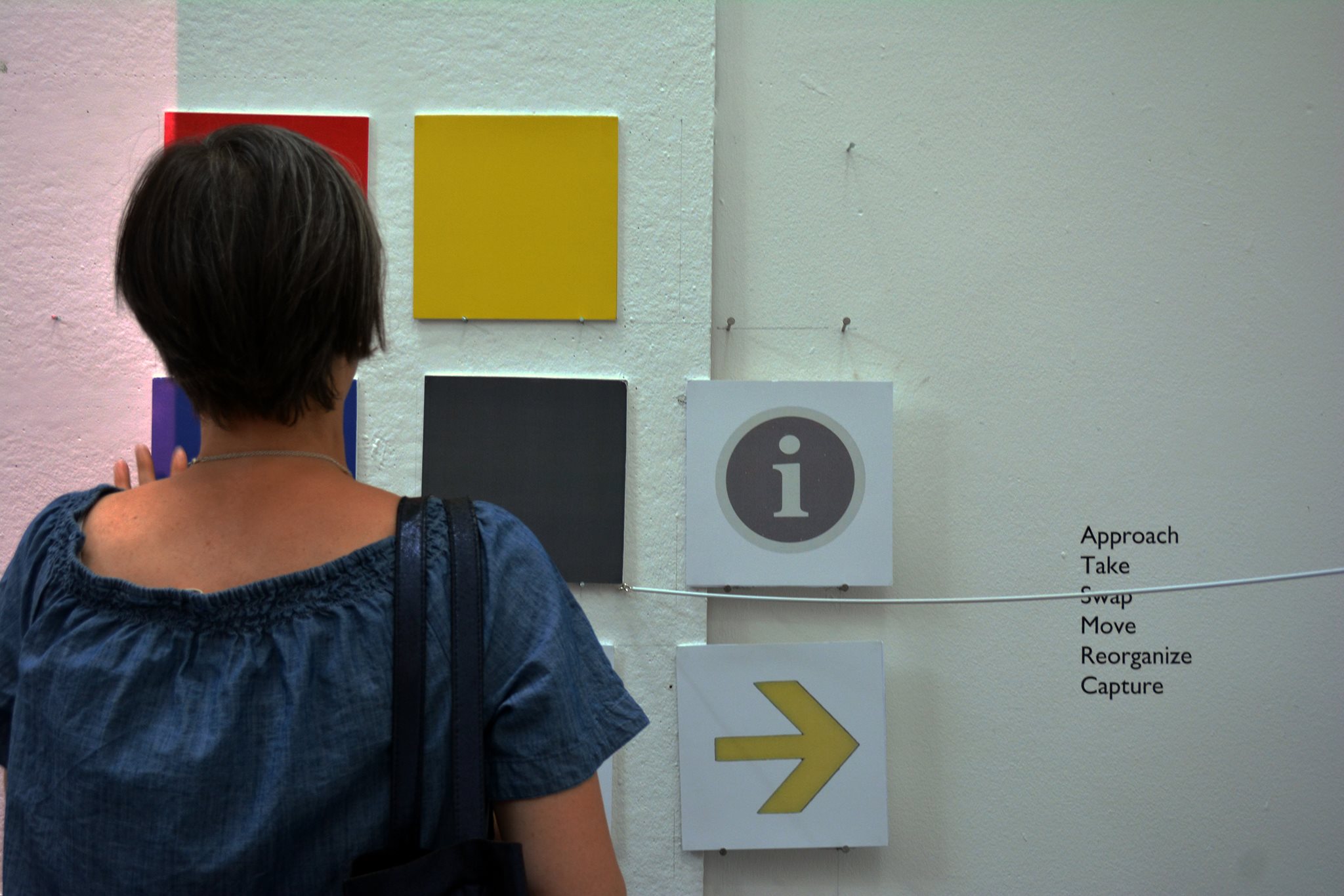Mark Granier responds to Life Above Everything
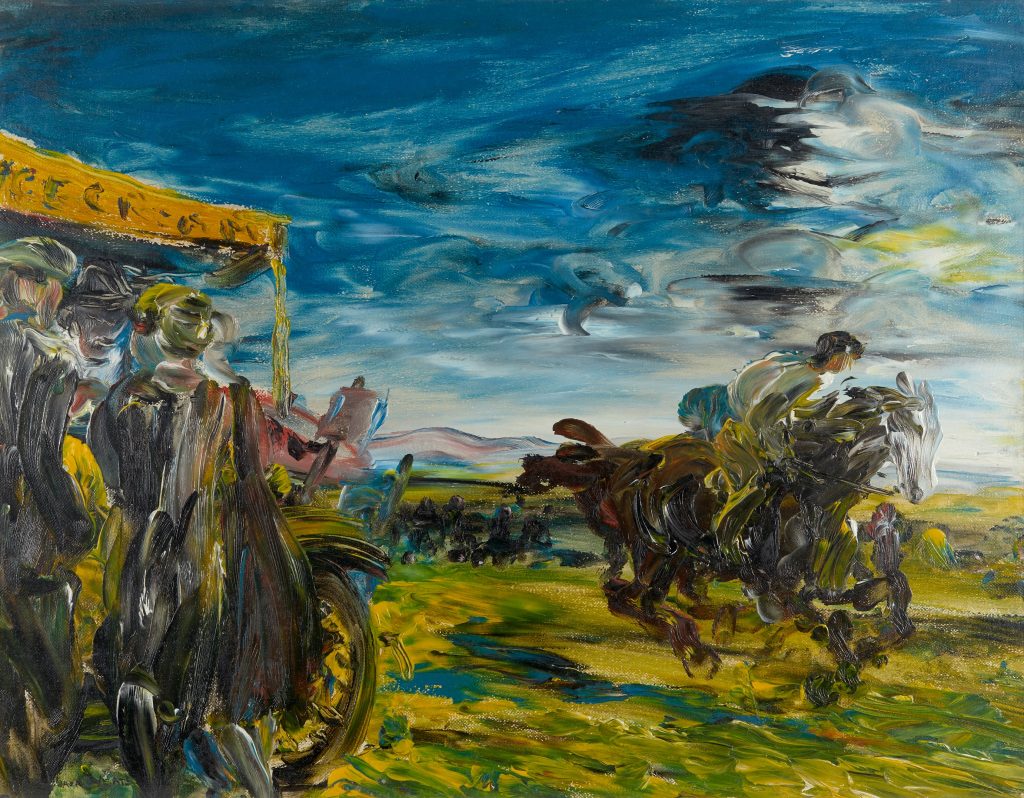
Published poet and award–winning photographer, Wicklow-based Mark Granier was first introduced to the Freud Project by friend and fellow poet Annie Freud (eldest daughter of Lucian Freud). Invited by IMMA to respond to the exhibition, Life Above Everything, Granier has written an essay, ‘Two Horses’, 2019 and a poem, ‘Two Painters’, 2019, which respond through “thoughts, sensations and images” to the “contrasts and synchronicities” of both painters and their shared love of subjects including horses, horse-racing and the human character.
……………………………………………………………….
Two Horses
[Yeats] …brings light, as only the great dare to bring light, to the issueless predicament of existence, reduces the dark where there might have been, mathematically at least, a door. –– Samuel Beckett
Nobody creates. The artist assembles memories. –– Jack B. Yeats
The longer you look at an object, the more abstract it becomes, and, ironically, the more real. –– Lucian Freud
Other depictive artists should look at Freud and either despair or get inspired. –– Robert Hughes
Soul clap its hands and sing, and louder sing
For every tatter in its mortal dress –– W.B. Yeats
I have been to the Life above Everything: Lucian Freud and Jack B. Yeats show at IMMA four times now, and on each subsequent visit I’ve been struck by something new, and also by how my memory had reworked some of the paintings, concentrating on or enlarging certain details while excluding others. Each time I’ve left with different thoughts, sensations and images shimmering in my head. Great paintings are life forms; you cannot hold one (let alone an entire houseful) entirely in your mind. I am not an art critic. What I want to set down here is largely subjective, a series of observations amounting to a personal response.
As others have remarked, the pairing of Lucian Freud and Jack Yeats is a far from obvious match, although Freud admired Yeats and advised a friend in the purchasing of several of his works (seven of these are on display in the exhibition). Freud also bought one of Yeats’s early works, The Dancing Stevedores (1900), and hung it in his bedroom. Luck then, happenstance; such relatively small gestures might have been lost in the footnotes if Freud’s friend and assistant, David Dawson, hadn’t recalled them and worked with IMMA’s Christina Kennedy to put together such a marvelous and unforgettable show.

Life Above Everything is an exhibition of both contrasts and synchronicities. The very different works of these two artists spark off each other and create some magical juxtapositions, such as Yeats’s The Sleeping Drover, Ballinasloe (1921) being placed next to Freud’s Double Portrait (1985-86). The former depicts a drover in a dark blue coat, curled up, sleeping against a tree in the foreground while a horseman gallops past behind him, at the edge of a busy country fair (crowds, a marquee, a carousel). Yeats has shrunk the perspective so that the man on the horse almost appears above the drover, as if he is dreaming it. Freud’s tender Double Portrait (1985-86) also depicts sleepers: one of Freud’s whippets, with its head and forepaws resting on a sleeping girl’s outstretched arm. Her other arm covers her eyes, with the dog’s muzzle pillowed in the open palm; it is, I think, one of Freud’s tenderest portraits.
If I remember correctly, these paintings are in a room on the ground floor, but a visitor could start by descending to the basement of the gallery, where the earliest works are hung.
Yeats initially worked as an illustrator: sketches in ink or watercolour of rural and urban life: Sligo, London, Dublin… workers and athletes at circuses, fairs, boxing matches, horse races, etc. The work I mentioned earlier, a large ink drawing Freud bought, The Dancing Stevedores, is an excellent example of these. It is packed with movement and humour, and has the energy-surge of Yeats’s best work, such as his later The Liffey Swim, for which he was awarded the silver Olympic Medal for Painting in 1924.
Freud’s slow, painstaking technique is evident in his early work. His Girl with Roses (1947-48) is academically brilliant, the technique restrained and highly polished, the brushwork fine and delicate, with an almost hyper-real sheen (he initially worked with sable brushes and experimented with enamel paints). Both Van Eyck and German Expressionism have been mentioned as possible influences; Freud denied the latter. There is a suggestion of psychological symbolism, or even religious martyrdom, in the girl, whose eyes are exaggeratedly large; also of course in the dying rose she appears to be gripping so anxiously. Other early works are on display. I was particularly fascinated by a pen and ink drawing from the same decade, Loch Ness from Drumnadrochit (1943). This shadowless, surreal little landscape is rendered in fine detail, each grass blade distinct, each pebble, tree, field and cloud quite different, like a cross between needlework and elaborate doodling.
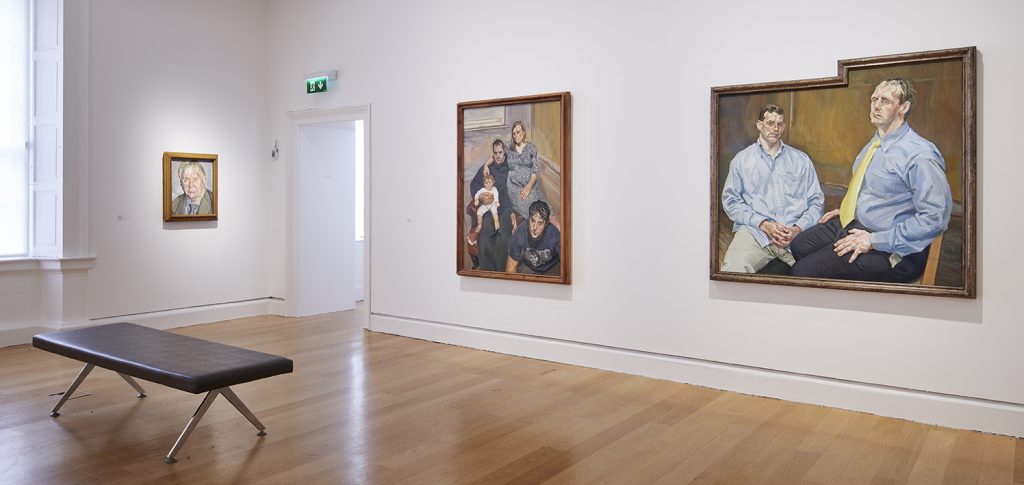
Yeats’s later works are like visions glimpsed through a downpour. They are full of their own wild weather. Facial features are often painted wet-on-wet, like ephemeral flotsam carried on a flood of movement and colour. The Bus By The River (1927) is an early example of this: the eyes, nose and mouth on the sunlit woman’s face are conveyed by the slightest of marks, yet her mood seems evident; she appears to glow, and smile, from within. In contrast, the man in the cap she is speaking to, because he is in shadow, is almost as dark as mahogany. Behind them, in the large bus-window, the river is alive with light. In a later urban scene, People in a Street (1936), the features of nearly everybody in the crowd, apart from one man in the foreground, are only barely suggested. Many of Yeats’s figures seem to be partly composed of the city, land or seascapes they stroll or sing or gallop across, scraped deftly together in ribbons of buttercup yellow, stone-grey, fuchsia-red, turf-brown…
Freud’s weather is much stiller, and quieter. His paintings are imbued with concentrated time, a sensation of overlaid moments, physically and, I think, psychologically dense. Freud has said that ‘as far as I am concerned, the paint is the person. I want it to work for me just as flesh does.’ While working as a visiting lecturer at The Slade he was introduced to a new paint, Cremnitz White, a paint so dense it appeared to have a sculptural plasticity. Freud decided this would be good to paint flesh tones, so lead-whites became a mainstay of his palette. Freud’s aphoristic remark on flesh/paint reminded me of Philip Larkin’s lines: ‘our flesh / Surrounds us with its own decisions.’ Freud’s paintings are a layering of decisions and impulses: in the placing of sitters, their relationships between objects in the room and windows, crumpled bed sheets or carefully placed props, like art books or photographs. The use of colour is mostly muted: a palette ranging from occasional ruddy flesh-tones (those middle-aged Irish faces for example) to variations on olive-drab and the earth pigments such as sienna and burnt umber.
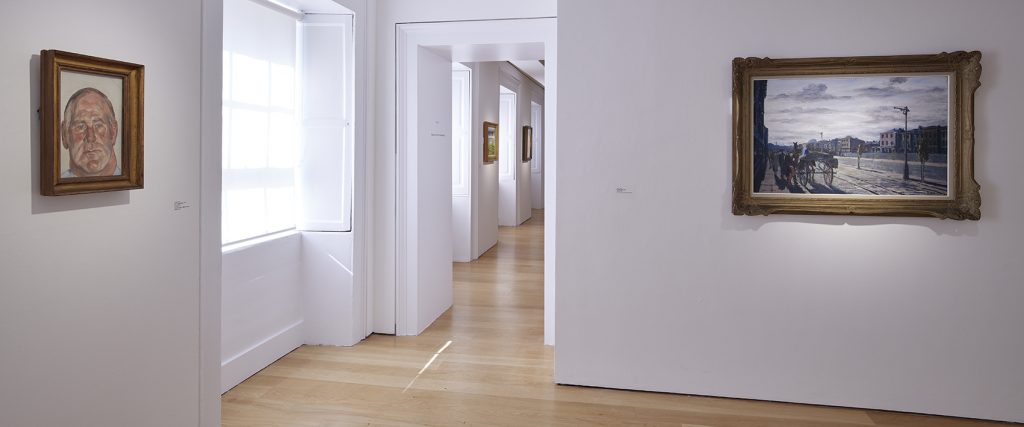
Yeats’s palette is broader, from burgundy and plum-dark interiors to land and skyscapes that tumble and scamper from white to cadmium yellow to sap-green, ultramarine, and so on (and all of these, or similar extraordinary contrasts, might be found in one painting). Yeats painted a number of self-portraits, but the people portrayed in his paintings, especially in the later work, are almost always involved in the larger world, whether it is an interior or landscape: leaning on a bridge, sitting at a table, stopping to talk on a city bus or country road, riding, walking, singing, watching a race… By contrast, Freud’s predominant obsession is with the human face and body, and recreating these through a complex anatomy of marks. The intensity can seem merciless, especially with some of his many nudes, though others can be kinder, such as the portrait of his young daughter, Annie, in Naked Child Laughing (1963), and the late portraits of his mother.
I don’t know what Jack Yeats’s father, John, would have made of Freud’s work, but I imagine he would have approved of Freud’s ongoing engagement with the self-portrait, something he kept urging his son to work on in his letters. Freud’s self-portraits are amongst his strongest work, meeting places where that unforgiving, critical gaze can confront itself eye to eye. Reflection (Self Portrait), 1985, is a perfect example. Step close, and the complex layering of marks becomes apparent, as do the instinctive decisions involved. Inside the first two pages of IMMA’s 2016 book Lucian Freud, there’s a marvelous reproduction of a detail of this painting: the eyes and part of the forehead and nose. The variety of marks and colours is a revelation: from lead-whites to terracotta to dark olive-black… Freud abandoned sable for hog’s hair brushes later in his career. Looking at it, I can hear the bristly stab of those brushes, the scrape of a palette knife, all that fierce, concentrated energy. It reminds me of a close-up I saw of a human eye lit in such a way as to reveal the tight-woven sphincter of the iris, its purse-string web of tendons and ligaments; we forget that our eyes are also flesh, musculature, and Freud’s work is mimetic in bringing this to light.
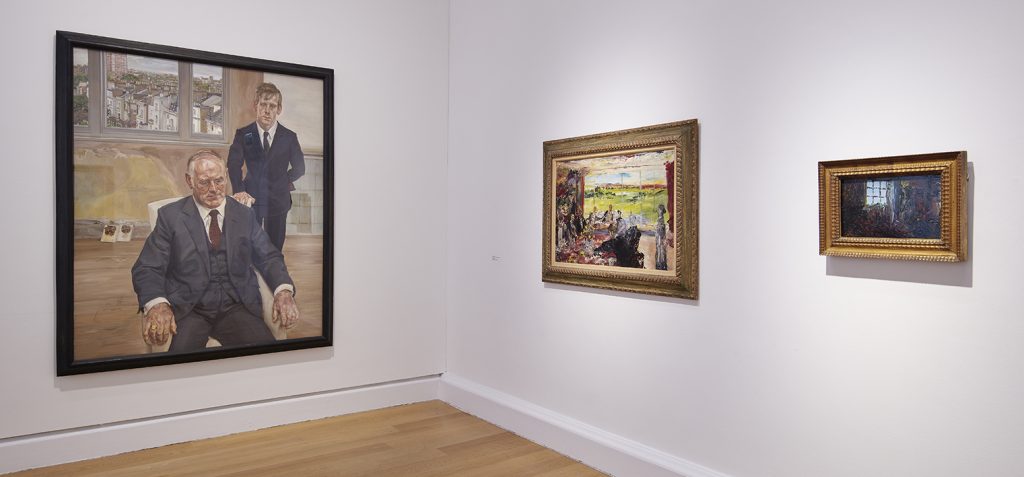
While Yeats’s paintings are highly theatrical, in treatment and often subject matter, Freud’s are, I think, more influenced by those mechanical media that Yeats distrusted: cinema and photography. Although he never worked from photographs, Freud plays with perspective like a photographer using different lenses. He often favours a slightly convex effect: the sitters in some of his portraits noticeably bulge outwards, either in their faces or bellies (especially the hands), depending on which angle or features Freud wishes to accentuate. In his aptly titled large portrait, Two Irishmen In W 11, 1984-85, our gaze is directed, as in a tracking shot, over the head of the father sitting in the armchair, with his son standing behind (both men in formal dark suits and ties), towards part of the small studio window that frames a beautifully detailed slice of a Notting Hill suburb: narrow Georgian houses, viewed at an angle, presumably part of Peel Street, flowing towards Camden Hill Road. Above the array of roofs and chimney pots in the near distance, London sprawls in all its oceanic anonymity, under a low, grey, cloud ceiling. Windows are a more persistent motif in Yeats’s work. In Yeats’s paintings, though, they appear less like transparent walls that separate inside from outside and more like dramatic thresholds by which a landscape enters, as in The Mountain Window (1946), in which the yellow-white panes of glass framing Ben Bulben are so rudimentary and insubstantial that the mountain is effectively in the room.
Above all, both Freud and Yeats were devoted to the stuff of paint and painterliness, the process of mark-making preserved in the afterlife of oil on canvas. The Dutch biographer Arnold Houbraken (1660-1719), believed that Rembrandt didn’t wish his paintings to be examined too closely, lest people detect a certain roughness in the technique. He claimed that Rembrandt attempted to discourage visitors from peering too closely by warning them that ‘the smell of colour’ would disturb them. A powerful ‘smell of colour’ applies to the later works of both Freud and Yeats.
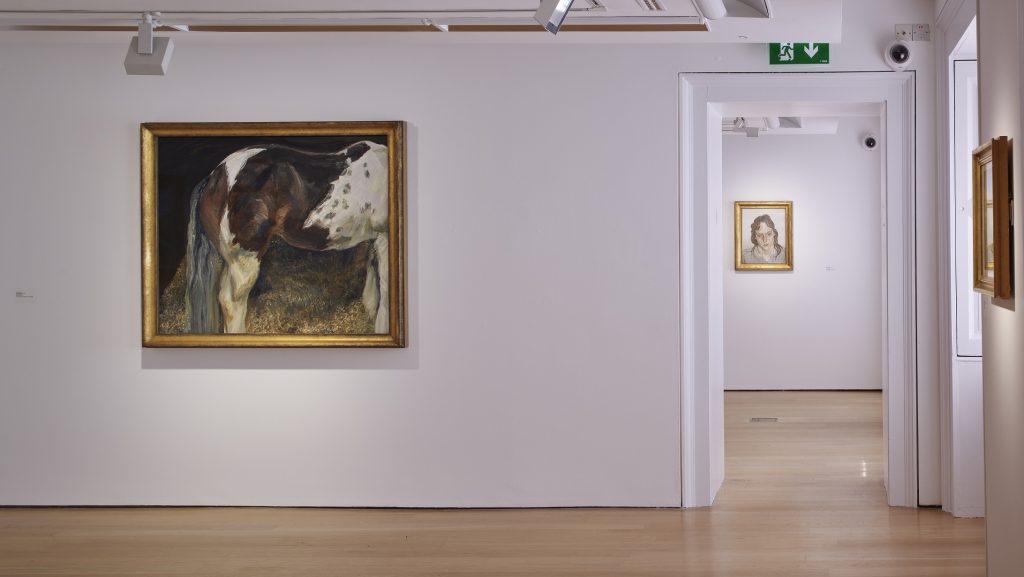
Both artists shared an interest in horses and horse racing. Freud was fond of placing a bet, and he painted a number of portraits of horses, such as A Filly (1970). Horses and horse-riders are everywhere in Yeats’s work. In The Flapping Meeting (1926) a rider gallops past what appears to be a cluster of people at an ice cream stall, presumably part of a fair or race. Horse and rider are whipped together out of a bundle of quick strokes, mostly of dark oil paint, but also of the yellow-green of the grass they are thundering over, and parts of sky-colour too. This is a lovely example of what Freud achieved in his later paintings; horses embody the energy of the technique itself.
Hung in the same room as The Flapping Meeting is a large, late painting by Freud, Skewbald Mare (2004). Skewbald means a combination of white and any other markings (chestnut, bay, etc.) besides black; black and white horses are piebald. The horse in Freud’s is in its stable and viewed from the side, so the eye can travel from the grey waterfall of its tail across its muscular haunch, along the croup and loin of its back up to the withers, just before the shoulder.
Hoofs, mane and head are out of the picture, so what is left is the main bulk of the horse’s muscular, powerful body: gorgeous colours and abstract shapes: burnt umber, cream, ermine, with two flashes of grey-white near the rump, like stalagmite and stalactite… It’s as if a stable door swung open; one can almost smell the hay and horseshit (Berger once wrote that the smell of horse or cattle dung is not unpleasant because ‘over the hill’ from that smell are the fields where they graze and pasture, whereas most humans are meat-eaters, so over the hill from our crap is death).
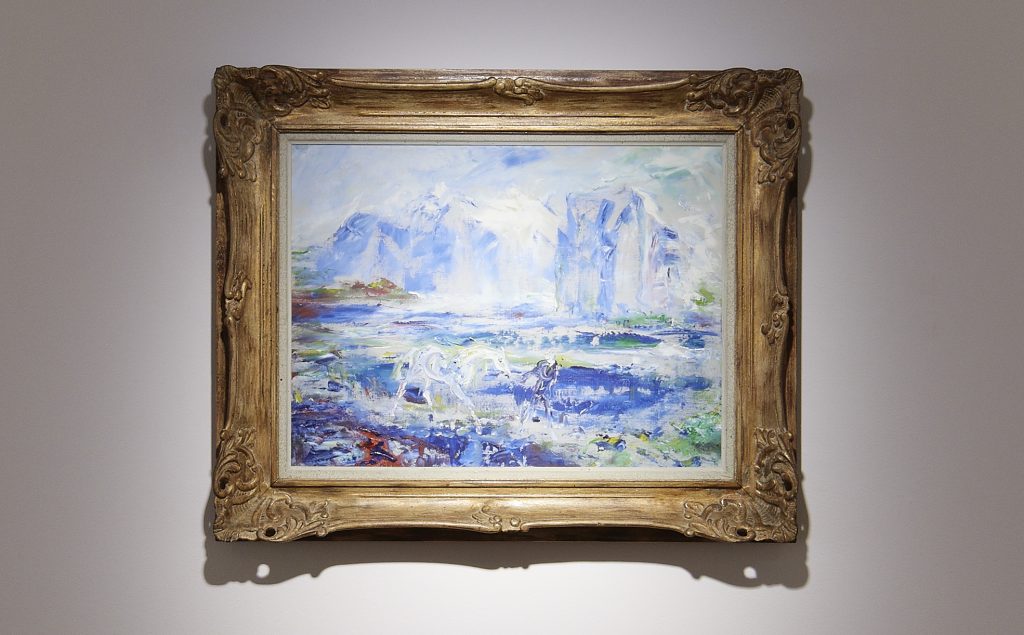
Facing this painting, across the gallery floor on the opposite wall, is another late work, Yeats’s Confidence (1949). This depicts two figures in a landscape, a dismounted, pale-faced rider leading a white horse along what might be a causeway across a stretch of water, or possibly a bog. In the background is a row of very roughly painted blue-white mountains that almost seem to crest and collapse, giant waves. The horse is all there, clearly delineated in a few quick strokes, surprisingly slim and graceful. The rider is slightly harder to make out, dressed in something almost the same blue as the water they’re crossing. The path or causeway is mainly unpainted, the grey of the primed canvas. The effect is one of lightness and delicacy, the palette, apart from streaks of yellow, ranging from dark red and blue in the foreground to the white and lilac of the mountains (which remind me of the Twelve Bens). The confidence is presumably that of the rider leading the horse, though it might apply to Yeats himself, and also of course to Freud. The two works complement each other perfectly: the visionary translucence of Yeats’s Confidence set opposite the grounded, rich density of Freud’s Skewbald Mare, its animal hinterland, the vision up close, reeking of oils, linseed, turps, horseshit, straw: two horses in the same stable, conversing with each other. The show would have been worth going to see, if only for this.

……………………………………….
Two Painters
What are we made and unmade of but wind and space
streaming its cities its bogs its rivers in spate,
windows in wine-dark rooms shimmering
like lakes, like Benbulben singing –– All painting
is cave painting –– made and unmade of the divine*
weightiness of flesh, floorboards –– time
slowed and scumbled and reworked over years to magnify
the vein in the hand, the suits, the ties
of businessmen and bookies, sitters who came and stayed
concentrated in that gaze
because what are we made and unmade of if not luck,
to return from a flutter
at Hy-Brasil, to the stable, the almost life-sized flank
of a skewbald mare wrapped and mapped
in warm continents of chestnut and grey-dappled ermine,
remodeled in paint and canvas as if pressed hard
into the bulging contour of the stone
*Quote from Jeanette Winterson
Categories
Up Next
IMMA After’s accomplishments 2018-2019
Fri Dec 27th, 2019